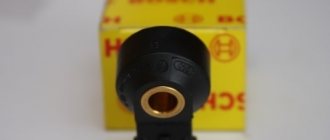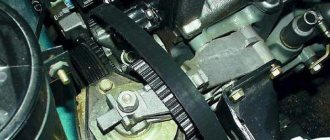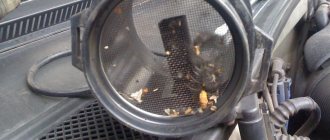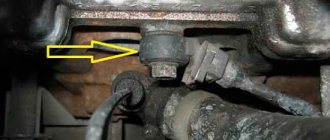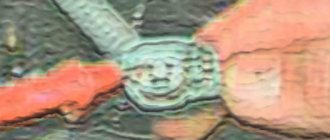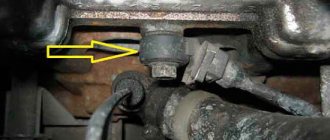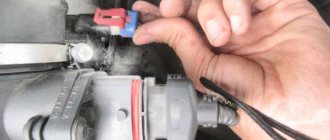The knock sensor is an important part of the car. The normal operation of the car engine depends on its functionality. Therefore, if a malfunction occurs, the owner needs to know where the knock sensor is located on the VAZ 2114 and be able to diagnose it. This article describes the location and purpose of the part, presents its main faults and their symptoms, as well as diagnostic methods.
How does a knock sensor work?
Car engines can use one of two types of knock sensors: resonant and broadband. But since the first type is already outdated and is rare, we will describe the operation of broadband sensors (WS).
The design of a broadband DD is based on a piezoelectric element, which, when subjected to mechanical action (that is, during an explosion, which, in essence, is detonation), supplies a current with a certain voltage to the electronic control unit. The sensor is configured to perceive sound waves in the range from 6 Hz to 15 kHz. The design of the sensor also includes a weighting agent, which enhances the mechanical effect on it by increasing the force, that is, it increases the sound amplitude.
The voltage supplied by the sensor to the ECU through the connector terminals is processed electronically and then a conclusion is made whether there is detonation in the engine, and accordingly, whether the ignition timing needs to be adjusted, which will help eliminate it. That is, the sensor in this case is only a “microphone”.
What is this?
To understand the essence of this device, let’s name its key features.
- DD, that is, the knock sensor, plays one of the main roles in the functioning of the engine. The device is responsible for controlling the degree of detonation and can determine the causes and nature of such a phenomenon. By supplying the appropriate information from the DD to the electronic control unit, characteristics that can lead to unwanted detonation are corrected.
- AvtoVAZ engineers could specifically place the DD in such a way that if problems arise with it, the driver could quickly and efficiently fix the problem. Alas, for some reason this was not done. Therefore, you will find this sensor on the engine block between its 2nd and 3rd cylinders. You need to look from the radiator side. Despite the inconvenient location, due to its reliable design, the developers still managed to minimize the likelihood of its failure. But this does not protect against breakdowns 100 percent. Therefore, sometimes the DD still needs to be replaced.
- For the VAZ 2114 model, several types of DD are used - broadband, with 1 and 2 working contacts, as well as resonant ones.
- The functioning of the DD is based on the reaction of the piezoelectric effect. Therefore, the main component of the element is a piezoelectric plate. They begin to generate energy as soon as detonation voltage vibrations occur. It increases depending on the frequency of oscillatory movements. The voltage from the sensor is transmitted to the control unit, which automatically adjusts the ignition timing, while debugging the ignition reaction of the fuel and air mixture.
Signs of a malfunctioning knock sensor
If the DD fails completely or partially, a malfunction of the knock sensor manifests itself according to one of the symptoms:
- Engine shaking . If the sensor and control system in the engine are working properly, this phenomenon should not occur. By ear, the appearance of detonation can be indirectly determined by the metallic sound emanating from a running engine (knock of fingers). And excessive shaking and jerking during engine operation is the first way to determine a malfunction of the knock sensor.
- Reduced power or “dullness” of the engine, which is manifested by deterioration of acceleration or excessive increase in speed at low speeds. This happens when, with an incorrect DD signal, the ignition angle is spontaneously adjusted.
- Difficulty starting the engine , especially “cold”, that is, at low temperatures after a long period of inactivity (for example, in the morning). Although it is quite possible for the car to behave this way even at warm ambient temperatures.
- Increased fuel consumption . Since the ignition angle is disturbed, the air-fuel mixture does not meet optimal parameters. Accordingly, a situation arises when the engine consumes more gasoline than it needs.
- Fixing knock sensor errors. Usually the reasons for their appearance are the signal from the sensor going beyond the permissible limits, a break in its wiring, or a complete failure of the sensor. The occurrence of errors will be indicated by the Check Engine light on the dashboard.
However, it is worth considering that such symptoms may indicate other engine failures, including other sensors. It is recommended to additionally read the ECU memory for errors that could arise due to incorrect operation of individual sensors.
Knock Sensor Circuit Malfunctions
In order to identify DD faults more accurately, it is advisable to use electronic error scanners for the electronic control unit. Especially if the check indicator light on the dashboard lights up.
Often, error p0325 “Open in the knock sensor circuit” indicates problems in the wiring. This could be a broken wire or, more often, oxidized contacts. It is necessary to perform preventative maintenance on the connectors on the sensor. Sometimes error p0325 occurs because the timing belt slips by 1-2 teeth.
Error P0328 “Knock Sensor High” often indicates a problem with high-voltage wires. In particular, if the insulation on them or the piezoelectric element breaks through. Similarly, this error can also occur due to the fact that the timing belt has jumped a couple of teeth. To diagnose, you need to check the marks on it and the condition of the washers.
Errors p0327 or p0326 are usually formed in the ECU memory due to a low signal from the knock sensor. The reason may be poor contact from it, or weak mechanical contact of the sensor with the cylinder block. To eliminate the error, you can try treating both the mentioned contacts and the sensor itself with WD-40. It is also important to check the sensor mounting torque, as this parameter is critical to its operation.
In general, it can be noted that the symptoms of a malfunction of the knock sensor are very similar to the symptoms characteristic of late ignition because the ECU, for the sake of safety for the engine, tries to automatically do it as late as possible, since this prevents destruction of the engine (if the angle is too early, then in addition detonation occurs, not only does the power drop, but there is also a risk of valve burnout). So, in general, we can conclude that the main symptoms are exactly the same as with incorrect setting of the ignition timing.
Causes of detonation
We have figured out the features of this effect, so now we need to figure out why this very detonation can occur.
| Cause | Explanation |
| Low quality of fuel used | When using fuel with a low octane number, its detonation is more difficult, which disrupts the operation of the ignition circuit of the air-fuel mixture |
| Incorrect ignition timing setting | To identify a malfunction, you should check the maximum and static value of the ignition timing. If they are discovered, serious problems may follow. DD must be verified |
| The combustion temperature of the mixture increases due to the lean composition | Due to a lean mixture, detonation occurs due to a decrease in fuel evaporation. As a result, the absorbed heat is reduced. This causes a sharp increase in temperature and the appearance of detonation. Visually, the malfunction can be determined by checking the spark plugs for deposits on them. |
| Malfunctions, increased back pressure inside the system | Any of these failures does not allow hot gases to exit the chamber, which causes detonation vibrations. |
| Operating the engine in extreme conditions | At critical loads, all the mentioned malfunctions combined may occur. These conditions include extreme heat |
When detonation occurs continuously, the engine and its components overheat. If this effect is not prevented, the power unit will soon fail completely. It is not a fact that even a major overhaul will allow it to be restored.
Examination
Causes of knock sensor malfunction
As for the reasons why problems arise with the knock sensor, these include the following breakdowns:
- Loss of mechanical contact between the sensor housing and the engine block . As practice shows, this is the most common reason. Typically, the sensor itself has a round shape with a mounting hole in the middle, through which it is attached to its seat using a bolt or pin. Accordingly, if the tightening torque in a threaded connection decreases (the pressing of the motor to the engine is weakened), then subsequently the sensor does not receive sound mechanical vibrations from the cylinder block. In order to eliminate such a breakdown, it is enough to tighten the mentioned threaded connection, or replace the mounting bolt with a mounting pin, since it is more reliable and provides a tight mechanical connection.
- Sensor wiring problems . In this case, there may be various problems, for example, a short circuit of the supply or signal wire to ground, mechanical damage to the wire (especially in places where it is bent), damage to the internal or external insulation, breakage of the entire wire or its individual wires (supply, signal), violation of the shielding braid. In this case, the problem is solved by restoring or replacing its wiring.
- Poor contact at the connection point . This situation sometimes happens if, for example, the plastic latch at the point where the sensor contacts are connected is broken. Sometimes, as a result of shaking, the contact is simply broken, and accordingly, the signal from the sensor or the power to it simply does not reach the recipient. To repair, you can try replacing the chip, correcting the contact, or using another mechanical method to try connecting two pads to the contacts.
- Complete sensor failure . The knock sensor itself is a fairly simple device, so there is nothing special to break there, and accordingly, it rarely fails, but it does happen. The sensor cannot be repaired, so in case of complete breakdown it is necessary to replace it with a new one.
- Problems with the electronic control unit . In the ECU, like any other electronic device, software failures can occur, which leads to incorrect perception of information from the DD, and accordingly, the unit makes incorrect decisions.
It is interesting that when a car owner contacts a car service center with complaints about the operation of the knock sensor, some unscrupulous repairmen immediately offer to replace it with a new one. Accordingly, take more money from the client. Instead, you can try tightening the torque on the sensor threaded mount and/or replacing the bolt with a stud. In many cases this helps.
Most common faults
In fact, cases of failure of the detonation detection device itself are not so common. In most cases, the reasons for incorrect operation are auxiliary factors, such as:
- Damage to the wires connecting the control unit to the sensor. As a result, the unit does not read signals from the device; contamination of the metal part of the part;
- corrosion (as a result of environmental influences);
- chafing breaks and wires;
- oxidation of one or both contacts.
Less commonly, there is a complete failure of the internal piezo element (plate) of the device. In most cases, the sensor cannot be repaired, and the repair itself is not entirely rational in terms of effort, time and money. The surest way is to buy a new product; fortunately, it is not expensive.
What are the effects of knock sensor malfunctions?
Is it possible to drive with a faulty knock sensor? This question interests motorists who are encountering this problem for the first time. In general terms, the answer to this question can be formulated as follows: in the short term, you can use the car, but at the earliest possible opportunity, it is necessary to carry out appropriate diagnostics and fix the problem.
Indeed, according to the principle of operation of the ECU, when a malfunction of the fuel knock sensor occurs, a late ignition is automatically set to prevent damage to the piston group parts if real detonation occurs during combustion of the fuel mixture. As a result, fuel consumption rises and dynamics drop significantly, which will become especially noticeable as the speed increases.
What happens if you turn off the knock sensor completely?
Some car owners even try to disable the knock sensor because under normal operating conditions and refueling with good fuel it may seem unnecessary. However, it is not! Because detonation occurs not only due to poor fuel and problems with spark plugs, compression and misfires. Therefore, if you disable the knock sensor, the consequences may be as follows:
- rapid failure (breakdown) of the cylinder head gasket with all the ensuing consequences;
- accelerated wear of elements of the cylinder-piston group;
- cylinder head crack;
- burnout (full or partial) of one or more pistons;
- failure of the jumpers between the rings;
- connecting rod bend;
- burning of valve plates.
This is due to the fact that if this phenomenon occurs, the electronic control unit will not take measures to eliminate it. Therefore, in no case should you turn it off and install a jumper from the resistance, because this is fraught with expensive repairs.
How to determine if a knock sensor is faulty
When the first signs of DD failure appear, a logical question is of interest - how to check and determine the malfunction of the knock sensor. First of all, it must be said that checking the knock sensor is possible without removing it from the cylinder block, or after removing it from its seat. Moreover, first it is better to do several tests when the sensor is screwed to the block. Briefly the procedure looks like this:
- set the idle speed to approximately 2000 rpm;
- With some metal object (small hammer, wrench), apply one or two gentle blows (!!!) to the cylinder block body in the immediate vicinity of the sensor (you can lightly hit the sensor directly);
- if the engine speed drops after this (this will be audible), it means the sensor is working;
- The speed remains at the same level - an additional check needs to be performed.
To check the knock sensor, a car enthusiast will need an electronic multimeter capable of measuring the value of electrical resistance, as well as DC voltage. The best way to check is with an oscilloscope. A diagram of the sensor operation taken with its help will clearly show whether it is operational or not.
But since only a tester is available to the average car enthusiast, it is enough to check the resistance readings given by the sensor when tapped. The range of resistance changes is within 400 ... 1000 Ohms. It is also imperative to carry out a basic check of the integrity of its wiring - whether there is a break, damage to the insulation or short circuit. You also cannot do this without the help of a multimeter.
If the check shows that the fuel knock sensor is working properly, but the error indicates that the sensor signal is outside the permissible range, then perhaps it is worth looking for the cause not in the sensor itself, but in the operation of the engine or gearbox. Why? Sounds and vibration are to blame for everything, which the engine can perceive as fuel detonation and incorrectly adjust the ignition angle!
Diagnostics and replacement of the knock sensor
Signs of sensor malfunction
If you begin to notice that your car’s engine is running unevenly (troiting), or its dynamics have deteriorated and the “CHECK ENGINE” indicator lights up on the instrument panel when you start to climb or when accelerating, then you should check the knock sensor for possible malfunction. The following instructions will help you diagnose and replace the knock sensor yourself.
Examination
So, on VAZ 2110, 2112, 2114, 2115, replacing the knock sensor begins with reading engine fault codes:
Error code 0325 indicates that there is a break in the electrical circuit of the sensor circuit.
It is necessary to carefully inspect and, if necessary, “ring” the entire circuit and clean the contacts in the sensor connectors, since the main cause of this error is oxidized contacts. In addition, it is necessary to check the timing belt, namely, whether it is installed correctly according to the marks; perhaps it has become loose and has jumped several teeth.
Error number 0328 indicates a high signal level from the knock sensor.
In this case, you need to pay attention to high-voltage wires. This error is issued when there is a breakdown of the power supply and the piezoelectric element, as well as when the valve clearance is increased
Again, recheck the timing belt.
Error codes 0326 and 0327 indicate that the signal level from the sensor is too low.
As in previous cases, we check the electrical circuit circuit; with the sensor removed, we treat the sensor and its contacts with special anti-corrosion agents. Pay special attention to the tightening torque of the sensor, which should be 10-24 N*m. If the instrument panel does not signal you with the “CHECK ENGINE” indicator light, then replacing the knock sensor on VAZ 2114, 2110, 2115 is accompanied by checking it with a voltmeter, for which:
If the instrument panel does not signal you with the “CHECK ENGINE” indicator light, then replacing the knock sensor on VAZ 2114, 2110, 2115 is accompanied by checking it with a voltmeter, for which:
- In the multimeter, set the voltmeter mode and enter the reading limit of 200 MV;
- On a two-contact sensor (broadband type) we connect the multimeter probes to the contacts, and on a one-contact (resonance type) - one to the contact, the second to the sensor body;
- Lightly tap the sensor body with a subsequent increase in impact force with a metal object (screwdriver or bolt) and observe the voltmeter readings;
- When impacted, a voltage surge should be observed: a stronger impact means a higher surge, otherwise the sensor definitely needs to be replaced.
Also, replacing the VAZ 2115 knock sensor may be accompanied by checking it with an ohmmeter, in which the resistance reading should be on a scale of 1-10 MOhm.
Replacement
Replacing the knock sensor of a VAZ 2112, 2110, 2114, 2115 is not difficult at all, so this instruction will not contain any additional video materials. As mentioned above, sensors of both types are installed on the engine cylinder block. The entire replacement process consists of the following:
- With the ignition off, disconnect the wire connector from the sensor, or one wire for a resonant type of sensor;
- In the first case, use a key set to “13” to unscrew the bolt securing the engine...
Replacing the knock sensor VAZ 2115
...and in the second, using a key set to “22”, we unscrew the block from the body and dismantle the device itself;
3. Install in reverse order.
Signs of a faulty knock sensor VAZ 2114
Signs of a malfunction of the VAZ 2110 knock sensor. Something always breaks in a VAZ. If the car owner knows the signs of a malfunction of the VAZ 2110 knock sensor (and, of course, other controllers) and knows how to read the errors shown by the ECU, this can make his life much easier. Not a single sensor is built into the car just like that; each one is designed by the designers to maintain and check the normal operation of various components.
From this point of view, the device that displays the level of detonation is particularly noteworthy. As long as the engine is running normally and no explosions occur, the engine can be said to be asleep. The car control system uses tabular, optimal parameters, giving instructions to the motor. However, if detonation occurs, the sensor instantly measures its strength, transmits the data to the on-board computer, and it reduces the advance angle. The correction occurs until the joint efforts of the motor control unit and the ECU stop the detonation, after which the sensor again seems to hide and fall asleep.
Thanks to such actions, all the troubles and dangers that arise from a detonating fuel-air mixture are prevented. And there are not so few of them, and they can sometimes cause significant damage to the engine unit in particular and the car as a whole. Signs of a malfunction of the VAZ 2110 knock sensor will help its owner understand what is happening with his car and take appropriate measures in a timely manner. About what visual points you should pay attention to, first of all, in order to detect a DD malfunction in time, and how to prevent it.
What you can notice first The knock sensor itself is quite reliable and does not fail very often. However, its performance should be checked in case of uncharacteristic behavior of the engine: a clear drop in engine power; “dullness” of the engine, increased speed at low speeds; deterioration of car acceleration; increased fuel consumption. It can reach +10%; smokier than usual exhaust. Tapping fingers and sudden jerks in movement may also be observed, but these are more individual reactions. Additional check Regarding electronic warnings.
Unfortunately, the control system often makes mistakes. So before trusting her information, it is worth conducting additional verification. Code 34 indicates failure of the DD. However, to make sure of this, you need to reset the self-diagnosis results, make a circle a couple of kilometers around the house and look at the readings again. If there is no error signal, it means that either the on-board computer was mistaken, or the sensor operates intermittently due to loose or oxidized contacts. Code 325 reports a broken DD. But often the unit records malfunctions of the throttle position sensor in its memory under these numbers. To check the assumption, you need to go into the menu and look at the voltage data on the suspected sensor: if the TPS is acting up, it will jump, while the detonation readings remain normal.
Searching for the cause As already mentioned, the DD is a surprisingly robust device. In most cases, it is enough to look for an open circuit, and first check the terminals. The wires ring if the self-diagnosis does not light up immediately, but when the engine spins above 3000 rpm. If the electrics are in order, the knock sensor itself is checked. It is located on the left in the direction of travel, where the air filter is located.
It is difficult to get to it, since the sensor is located between the cylinders - this allows it to take readings from the entire block. The sensor is dismantled. To do this, you will need a 13 socket key if your machine has a single-pin DD, and a 22 socket if it has a two-pin one.
Take a voltmeter with good sensitivity and set it to a mode of up to 200 MV. If there are 2 contacts, the sensor connectors are connected to the device. On another type of sensor, one probe is thrown onto the contact, the second – onto the body. Using a screwdriver, bolt or heavy pen, tap the body with varying strength (but without zeal). The voltmeter readings should fluctuate: the more noticeable the shock, the larger the jump.
If the device does not respond to influences, you need to change the sensor. Sometimes people try to save money on it by buying a used one, but this is not worth doing: a new one costs 200-300 rubles, which can be considered quite affordable, and a used one may be in even worse condition than a removed one. If all checks have been carried out and even the DD has been replaced, but signs of a malfunction of the VAZ 2110 knock sensor remain, then the problem is not at all with it.
Detonation is caused by other factors, among which the first place is gasoline poured in an untested place. However, other factors may also have an effect: compression problems, flooded or burnt-out spark plugs, etc. If you are confident in the integrity of the knock sensor, you will have to dig much deeper into the insides of the car.
Why does detonation occur in engine cylinders?
Experts identify several main reasons why fuel detonates in the engine.
First of all, it is worth immediately highlighting the use of low-octane gasoline in units with a high compression ratio. Simply put, the octane number of gasoline (AI-92, 95 or 98) actually indicates its resistance to detonation, and not its quality, as many people mistakenly believe.
The use of fuel with an inappropriate octane number for a particular engine naturally leads to the fact that the fuel-air charge detonates under strong compression. Let us also add that simple engines that do not have an ECM and a knock sensor are at greater risk.
Engine coking
It is important to understand that modern engines not only in foreign cars, but also in domestic cars are very different from their analogues from the times of the USSR. In a nutshell, if the engines on the Moskvich 2141 model had a compression ratio of about 7 units and worked normally on any fuel, today the units have from 9 to 11 or more units
In this case, a decrease in the physical volume of the combustion chamber as a result of the formation of a carbon layer will lead to the fact that the fuel charge in the cylinder will be compressed more strongly, and detonation will appear. If we add to this the low quality of fuel at domestic gas stations, then the risks increase even more.
Violation of the mixture formation process. In this case, a too “rich” mixture, in which there is a lot of fuel in relation to the amount of air, may begin to detonate.
Note that such detonation can be short-term and often goes unnoticed by the driver, however, it is impossible to say that there is no harm to the engine.
Ignition timing (IDA). In simple words, the ignition angle determines at what point the spark will be supplied to the combustion chamber. If we consider that normally fuel does not explode, but burns, then it becomes clear that the combustion process also takes some time.
In this case, it is important to ensure that the maximum gas pressure on the piston, which is formed as a result of the combustion of a portion of fuel, occurs precisely at the moment of the working stroke of the piston. This is the only way to effectively transfer the energy of expanding gases to the crankshaft through the piston.
To do this, the spark can be applied a little earlier than the moment the piston reaches top dead center (TDC). During this time, the fuel will have time to ignite, and the expansion of gases and an increase in pressure on the piston will occur just at the moment when the piston has already reached TDC and then goes down.
Currently reading
At the same time, you need to understand that incorrect adjustment of the ignition moment (shift of the ignition moment closer to TDC), when the mixture ignites almost when the piston has already risen to the top dead center, often becomes the cause of detonation. Again, we traditionally add to this the low quality of fuel.
Design features of the combustion chamber. It happens that some engines are initially prone to detonation. In some cases, the reason is the design of the combustion chamber itself, the implementation of its cooling, etc.
Another culprit may be pistons that have an unsatisfactory thermal balance (for example, the piston bottom is thickened closer to the center, which noticeably worsens the quality of excess heat removal). One way or another, the risk of detonation on such engines is much higher.
Engine overheating
If you pay attention to the previous point, it becomes clear that an increase in temperature in the combustion chamber is the cause of detonation. It is quite obvious that a decrease in the efficiency of the cooling system can lead to the engine overheating
Under such conditions, detonation is quite likely to occur, and detonation itself also additionally leads to local and general overheating. For this reason, engine detonation as a result of a faulty cooling system is especially dangerous, since the power unit can not only be severely damaged, but also cannot be repaired in the future.
Where is the knock sensor on a VAZ 2114
I’ll start today’s article with a story about what a knock sensor (DS) is and why a car engine needs it. This sensor is necessary, as the name implies, in order to monitor detonation in the engine, as well as knocking noises that indicate malfunctions.
Each knock causes the sensor to produce a pulse with a certain voltage. After this, the pulse goes to the controller, which performs subsequent processing. The controller adjusts the ignition timing depending on the size of the received impulse; the whole process takes a few fractions of seconds, so most often we simply cannot feel anything.
DD belongs to that category of automotive sensors that fail very rarely, for which a HUGE driver’s THANK YOU to him and his creators!
Where is the knock sensor located?
The VAZ 2114-2115 knock sensor is located between the second and third cylinders on the engine block; it can be one- or two-contact.
What do you need to know about the phase sensor?
So, what is a VAZ 2114 phase sensor, how to find it and what are its signs of malfunction?
Device and purpose
DF installation location
DF is a regulator necessary to obtain data on the functioning of the vehicle engine and transmit this information to the ECU. As for the design, the DF consists of a sensitive component as well as a pulse converter. The design of the latter, in turn, includes an operational amplifier, an output stage, and a bridge circuit.
The sensing component located inside the structure operates on the principle of a Hall regulator. Its purpose is to transmit an impulse at the moment when a magnetically conductive component is located next to the microcircuit. As for the location of the VAZ phase sensor, it is located on the side of the cylinder block, next to the air filter element.
Malfunctions
A device failure can be identified by certain signs:
- increased gasoline consumption;
- malfunctions in the machine’s self-diagnosis;
- decreased dynamics when accelerating a car;
- Errors 0343, 0340 or a Check lamp may appear on the control panel.
The light bulb Check usually appears if the DF is inoperative.
How to connect DF correctly
Check and replacement
To check on an eight-valve engine, you must perform the following steps:
- At the multimeter terminal V1, you need to set the voltage to 13.5 volts; this probe is connected to pin E. At the second pin, which is connected to pin B, you need to set the voltage to 0.9 volts.
- After closing the contacts, a screwdriver or plastic steel should be brought to the end of the regulator. And if the DF is functioning properly, the voltage at output B should drop to 0.4 volts. If the readings differ, then the DF should be replaced (the author of the video is In Sandro’s garage).
To your attention errors in the knock sensor VAZ 2114
- Error code 0325 - there is a break in the wiring that supplies power to the DD. Most often, the cause of this error is oxidized contacts of the knock sensor; a wiring break occurs extremely rarely. It is necessary to clean the contacts, this will give a positive result, at least it will not get worse. In addition, this error can be caused by the timing belt, so if after cleaning the DD contacts the problem remains, check the timing belt, most likely it has jumped a couple of teeth. Align the belt to the marks and check again if the error appears.
- Error code 0328 - as a rule, indicates faulty high-voltage wires. However, the possibility of the timing belt jumping cannot be ruled out.
- Error code 0326 , as well as 0327 , mean an excessively weak (low) signal from the knock sensor. To eliminate errors, it is necessary to clean the VAZ 2114 DD connection contacts. The tightening torque of the sensor is also important; if the tightening is weak, the above errors may appear.
How to check the knock sensor of a VAZ 2114-2115
- Prepare the end face at “13” or “22” (depending on the type of sensor).
- Multimeter or voltmeter.
- Screwdriver.
Sequencing:
- Remove the sensor from the engine block.
- Turn on the voltmeter or multimeter in operating mode with a limit of 200 mV.
- Connect the multimeter electrodes to the knock sensor terminals, then use a screwdriver to tap the part body.
- While tapping, observe the changes on the device display; depending on the strength of the blows and frequency, the voltmeter readings should change. If your knock sensor readings do not change, it is faulty and needs to be replaced.
VAZ knock sensors come in two types:
- Resonant (made in the shape of a barrel).
- Broadband (made in tablet form).
These sensors are completely different, so before you buy a knock sensor for a VAZ 2114 or 2115, check which one you have installed.
Step-by-step replacement procedure in case of malfunction
- In order to change this sensor on a VAZ-2114, no special skills are required.
- First of all, open the hood and look for DD with the engine off.
- If you have a broadband sensor, then you need a 13 key, and if the sensor is single-contact, then a 22 key will be useful.
- Then in the first case we unscrew the nut to 13 and in the second case the sensor is unscrewed with a head to 22.
As you can see for yourself, replacing the knock sensor on a VAZ-2114 is not difficult.
Source
Why do you need a knock sensor on a VAZ 2114?
The operation of the VAZ 2114 power unit may be accompanied by the appearance of detonation. It has a bad effect on the engine, creating parasitic vibration and having a destructive effect on the main elements of the internal combustion engine.
Damage and metal fatigue gradually accumulate in the engine, which results in the imminent need for major engine repairs. A combination of electronic control units and DD is working to eliminate detonation. The meter detects the occurrence of non-optimal ignition of the fuel-air mixture, and the main module corrects the spark advance angle.
How to eliminate engine detonation
So, having considered the main causes of engine detonation and having understood what it is, we can move on to how to get rid of this phenomenon. Let's start with old internal combustion engines. At the very beginning, you should exclude overheating of the engine, as well as refueling with low-quality or unsuitable fuel, and check the spark plugs.
Further, if a knock sensor is not installed on the engine, then the manifestation of its signs indicates the need to adjust the SPD. To do this, you need to reduce the ignition timing by turning the distributor. The main thing is to ensure that the engine runs stably at idle.
The solution is temporary, since you cannot drive for a long time with a reduced ignition angle (the exhaust valves will burn out as a result of an increase in the temperature of the exhaust gases), but getting to the service center on your own is quite possible.
However, while driving, you need to constantly ensure that there is no characteristic “ringing” in the engine. You can also install a so-called electronic octane corrector on an old internal combustion engine to avoid manipulations with the distributor. Let us also add that, as practice shows, many owners of carburetor cars prefer to install electronic ignition.
As for more modern engines, injection units are equipped with standard solutions to avoid or minimize the risk of detonation. We are talking about an engine knock sensor (DE), which detects its occurrence. Then the corresponding signal is sent to the ECU.
Then the control unit independently adjusts the ignition timing taking into account the data received from the DD. Moreover, the possibility of such adjustment is, on average, an angle shift of 2 – 5 degrees. If it is not possible to get rid of detonation in this way, the ECU records the error and writes it to its memory, a “check” may light up on the instrument panel, the engine goes into emergency mode, etc.
The same thing happens when the knock sensor itself fails or the fuel turns out to be too unsuitable, that is, the controller is simply not able to remove the knock by means of a programmed shift in the ignition timing.
It becomes clear that in this case, the driver at the initial stage needs to start by checking the knock sensor, and also read errors from the ECU memory. This can be done as part of computer engine diagnostics. You can also perform the check yourself (if you have a special diagnostic scanner adapter for the OBD connector and a smartphone/tablet or laptop with pre-installed software).
- Engine diagnostics using spark plugs
How to check engine performance using spark plugs. The main signs of engine malfunctions: the appearance of black, gray, red and white carbon deposits on the spark plugs. Read more
- How to determine early or late ignition
Signs for determining the correct ignition timing. Consequences of an incorrectly configured OZ, methods for setting the ignition. Read more
- What is an engine knock sensor
Purpose and design of the knock sensor. The main causes of detonation, types and operating principle of the sensor. Read more
- Engine detonation: what is it?
Why does the fuel-air mixture detonate in the combustion chamber? Reasons causing detonation. Consequences of detonation combustion of fuel in internal combustion engine cylinders. Read more
- Consequences of car engine overheating
Why does the engine overheat? What should the driver expect and what damage may occur if the engine overheats. What to do if the internal combustion engine overheats. Read more
- Basic malfunctions of the engine cooling system
Common engine cooling system failures: water pump, thermostat, radiator, cooling fan and others. How to determine the reasons yourself. Read more
Purpose of the knock sensor
Early VAZ 2114 models used a resonant knock sensor. Subsequently it was replaced by broadband. Both DDs have a similar principle of operation, but differ significantly in design. Therefore, they are absolutely non-interchangeable.
The broadband DD is made in the shape of a round torus. It is attached to the engine with a bolt passing through a hole located in the center. There is a two-pin connector on the side of the torus for connection to the main module.
Fixing the resonant knock sensor does not require the use of a bolt. On one side of its body there is a thread with which it is screwed into a seat on the cylinder block.
A piezoelectric element is located inside both types of DD. It is sensitive to vibration and shock. The difference between the resonant DD is its narrower control range.
An electrical signal of a certain frequency and amplitude is generated inside the knock sensor. It goes to the ECU. The electronic control module monitors and analyzes the received signal. When detonation is detected, the ECU adjusts engine operation according to the established algorithm.
Eliminating detonation minimizes parasitic loads on the engine. As a result, the engine resource increases. This is what the knock sensor affects.
Useful tips
Recently, cases of selling defective spare parts and sensors without the necessary internal contents have become more frequent. Therefore, immediately after purchasing the product you need, it is recommended to check its performance with a multimeter. You should know that on older VAZ 2114 models the knock sensor (resonant) differs from modern products (broadband) in price, design features and operating principles. Therefore, you should buy a product that is designed specifically for your car model. A device with a resonant type of operation cannot be replaced by modern products without modifying the ECU.
Location of the knock sensor on the VAZ 2114
The location where the DD is located is selected in such a way that the sensor has the greatest sensitivity. Therefore, the DD is mounted directly on the cylinder block. You can find the location by tracing the wires coming from the electronic engine control unit. It is easier to do this on a VAZ 2114 with an 8-valve engine, since its engine compartment layout is less loaded. On a car with 16 valves, it is more difficult to determine what each loop and sensor is responsible for.
Sensor cost
On VAZ 2114 cars of early production years there is a Lada sensor 21120385501001. It has an extremely low prevalence and because of this its price is high and amounts to 800-1300 rubles. The only commonly found analogue is General Motors 21120-3855010-01 with a cost of 1600-1800 rubles.
The original broadband DD has article number 21123855020. Its price is much lower and amounts to 100-160 rubles. Its good analogues are presented in the table.
Table - Good analogues of the original VAZ 2114 knock sensor
| Manufacturer | vendor code | Approximate cost, ruble |
| Fenox | SD10100O7 | 210-420 |
| Decaro | 2112-3855020 | 360-490 |
| Samara 2112 | 3855020 | 200-250 |
| Road map | 21123855020 | 260-380 |
| ERA | 550489 | 300-340 |
Which to choose
Experts recommend buying an original knock sensor; it is suitable for Kalina of the first (8-valve) and second (16-valve) generations. Serial number 21120-3855020-01 or 02. The difference is that the first is produced at AvtoVAZ, and the second at related enterprises. But they are both original.
How to check
Even a new sensor must be checked, as defects may occur. To do this, take a tester and ring the circuit. Turn on the ohmmeter mode. It should be at least 5 ohms. If we switch to voltage mode, we get an operating alternating voltage: U= 0.5−3 V. These parameters indicate the health of the device.
Methods for checking a knock sensor
If signs of malfunction of the DD appear, then you should check for errors. About problems with the knock sensor they say:
- code 0326, indicating the signal level is too high;
- code 0327, indicating a low signal level, for example, due to the fact that the tightening torque does not correspond to the nominal one;
- code 0325, there is an open circuit in the circuit
You can check the DD by measuring the resistance.
You can check the DD with a multimeter. To do this, check the presence of voltage at the sensor outputs when tapping it with a metal rod.
Self-replacement of sensor 21120385501001 on a VAZ 2114
Replacing the resonant DD is carried out according to the instructions below.
- .De-energize the on-board network.
- Remove contact with DD.
- Unscrew the sensor.
- Dismantle the DD.
- Install the new one in reverse order.
Replacing broadband DD on VAZ 2114
The broadband DD is replaced according to the algorithm below.
- Disconnect the terminal and unscrew the sensor.
- Remove DD.
- Install the new wideband sensor in reverse order.




